Numerical Analysis of Mechanical Characteristics of Constant-Resistance, Energy-Absorbing and Anti-Scour Bolts
Abstract
:1. Introduction
2. Design of Constant-Resistance Energy-Absorbing Anti-Scour Anchor
2.1. Design of Constant Resistance Anti-Impact Device
2.2. The Composition of a Constant-Resistance Energy-Absorbing Anti-Scour Anchor
2.3. The Working Principle of a Constant Resistance Energy-Absorbing Anti-Scour Anchor
3. Analysis of Mechanical Properties of an Anchor under Static Load
3.1. Model Building and Parameter Setting
3.2. Comparative Analysis of Mechanical Properties with Conventional Anchor
4. Analysis of Mechanical Properties of Anchor under Impact Load
4.1. The Law of Impact Energy on The Mechanical Properties of Anchor
- (1)
- When the impact energy of the surrounding rock is 25 kJ, both conventional anchor rod and constant resistance energy-absorbing impact anchor rod are not broken; when the impact energy of the surrounding rock is 50 kJ, the conventional anchor rod is broken and the constant resistance energy-absorbing impact anchor rod is not broken; when the impact energy of the surrounding rock is 80 kJ, both the conventional anchor rod and constant resistance energy-absorbing impact anchor rod are broken. It shows that the constant resistance energy-absorbing impact anchor has good mechanical properties of impact resistance;
- (2)
- Under static load and 50 kJ and 80 kJ impact energy dynamic load, the yield load of the rod is 178, 183 and 183 kN, the breaking load is 226, 227 and 224 kN, the absorbed energy is 43, 41 and 43 kJ, and the yield distance is 240, 233 and 237 mm respectively. Compared with the static load, the yield load of the rod slightly increases, the yield distance slightly decreases, and the breaking load and absorbed energy remain the same. The effect of impact energy on the mechanical properties of conventional anchor rods can be ignored;
- (3)
- Under static load and 80 kJ impact energy dynamic load, the yield load of the rod is 178 and 184 kN, the breaking load is 226 and 224 kN, the absorbed energy is 66 and 60 kJ, the yield distance is 375 and 370 mm, and the load capacity of the impact prevention device is 162 and 156 kN. Compared with the static load, the yield load of the rod increased slightly, the breaking load was basically unchanged, and the absorbed energy, the yield distance and the load carrying capacity of the anti-squeezer decreased by 9%, 3% and 4%, respectively;
- (4)
- With the increase in impact energy, the bearing capacity of the deformation phase of the anti-puncher is 152~156 kN, which indicates that the anti-puncher has a more constant bearing capacity and deformation load threshold;
- (5)
- When the impact energy of the surrounding rock is 80 kJ, the yield load of the rod is 183 and 184 kN, the breaking load is 228 and 227 kN, the impact resistance time is 35 and 65 ms, the absorbed energy is 43 and 60 kJ, and the yield distance is 229 and 370 mm for the conventional anchor rod and the constant resistance energy-absorbing impact anchor rod, respectively. The impact resistance time, absorbed energy and yield distance are 1.86, 1.40 and 1.61 times of conventional anchor rods, respectively, which means that the impact resistance mechanical performance of constant resistance energy-absorbing anchor rods is significantly better than that of conventional anchor rods.
4.2. The Law of Impact Velocity on The Mechanical Energy Absorption of Anchor
- (1)
- At impact velocities of 2, 4, 6 and 8 m/s, the rod yield load is 181, 181, 182 and 183 kN, the breaking load is 228, 228, 227 and 224 kN, the absorbed energy is 44, 43, 44 and 43 kJ, the yield distance is 242, 239, 245 and 237 mm, and the impact resistance time is 139, 69, 48 and 35 ms. It shows that the impact velocity has a small effect on the rod yield load, breaking load, absorbed energy and yield distance of conventional anchor rods, and the impact time decreases non-linearly with the increase in impact velocity;
- (2)
- When the impact velocity of constant resistance energy-absorbing anti-shock anchor is 2, 4, 6 and 8 m/s, the yield load of rod is 181, 181, 184 and 184 kN, the breaking load is 227, 226, 228 and 224 kN, the absorbed energy is 66, 64, 65 and 60 kJ, and the yield distance is 377, 377, 375 and 370 mm, respectively. The impact resistance time was 258, 144, 101 and 65 ms, respectively, indicating that the impact speed had a small effect on the rod yield load, breaking load, absorbed energy and yield distance of the constant resistance energy-absorbing anchor, and the impact resistance time decreased non-linearly with the increase in impact speed;
- (3)
- The bearing capacity of the impact prevention device in the deformation phase at the impact speed of the surrounding rock is 2, 4, 6, and 8 m/s is 156, 149, 153, and 155 kN, the impact resistance time is 79, 39, 27, and 20 ms, and the yielding distance is 134, 132, 132, and 135 mm, indicating that the impact prevention device at different impact speeds has a more constant bearing capacity and a higher stroking efficiency;
- (4)
- Under the same impact velocity, the three indexes of constant resistance energy-absorbing anti-impact anchor rods, such as yielding distance, impact resistance time and energy absorption, are significantly better than those of conventional anchor rods.
5. Field Applications
5.1. Site Overview
5.2. Field Test Results
6. Conclusions
- (1)
- Based on the requirements that the anchor rod anti-scouring device should have a reasonable deformation load threshold, high stroke efficiency, a constant reaction force and stable repeatable deformation damage mode, a constant resistance anti-scouring device is designed. Additionally, a constant-resistance energy-absorbing anti-stroke anchor rod consisting of rod body, tray, anti-stroke and profiled nut is designed, and the working principle of constant-resistance energy-absorbing anti-stroke anchor rod is given;
- (2)
- The constant resistance energy-absorbing anti-stroke anchor has a stable and repeatable deformation damage mode under both static and impact loads. The impact energy and impact velocity have less influence on the load carrying capacity and stroke efficiency of the constant resistance anti-impact device;
- (3)
- The impact velocity has a small effect on the indices of rod yield load, breaking load, absorbed energy and yield distance of conventional anchor rods and constant resistance energy-absorbing anti-shock anchor rods, and the impact resistance time all decreases non-linearly with the increase in impact velocity;
- (4)
- Under static and impact loads, the three indexes of constant resistance energy-absorbing anti-shock anchor rods, such as yielding distance, impact resistance time and energy absorption, are significantly better than those of conventional anchor rods.
Author Contributions
Funding
Institutional Review Board Statement
Informed Consent Statement
Data Availability Statement
Conflicts of Interest
References
- Pan, Y.S. Disturbance response instability theory of rockburst in coal mine. J. China Coal Soc. 2018, 43, 2091–2098. [Google Scholar]
- Jiang, Y.; Pan, Y.; Jiang, F.; Dou, L.M.Y. State of the art review on mechanism and prevention of coal bumps in China. J. China Coal Soc. 2014, 39, 205–213. [Google Scholar]
- Tang, Y.; Hang, L.; Wang, Y.; Zhao, Y. Rock slope stability analysis considering the effect of locked section. Bull. Eng. Geol. Environ. 2021, 5, 7241–7251. [Google Scholar] [CrossRef]
- Zhao, Y.; Wang, Y.; Wang, W.; Tang, L.; Liu, Q.; Cheng, G. Modeling of rheological fracture behavior of rock cracks subjected to hydraulic pressure and far field stresses. Theor. Appl. Fract. Mech. 2019, 101, 59–66. [Google Scholar] [CrossRef]
- Zhao, Y.; Wang, Y.; Wang, W.; Wan, W.; Tang, J. Modeling of non-linear rheological behavior of hard rock using triaxial rheological experiment. Int. J. Rock Mech. Min. Sci. 2017, 93, 66–75. [Google Scholar] [CrossRef]
- Liu, J.; Zhao, Y.; Tan, T.; Zhang, L.; Zhu, S.; Xu, F. Evolution and modeling of mine water inflow and hazard characteristics in southern coalfields of China: A case of Meitanba mine. Int. J. Min. Sci. Technol. 2022. [Google Scholar] [CrossRef]
- Zheng, D.J.; Sun, Q.R. Determination and experimental study on technical parameters of bolt -shotcrete support for deep rock roadway. Coal Mine Saf. 2021, 52, 60–65. [Google Scholar]
- Zhang, J.; Liu, D.; Li, H.B.; Yan, Y.L. Optimization of roadway bolt support in gob-side entry retaining. Coal Eng. 2021, 53, 97–101. [Google Scholar]
- Liu, X.; Hua, X.Z.; Yang, P.; Yang, S.; Ma, Y. A quantitative study on roof dislocation criterion and support parameters of entry retaining by roof cutting in deep mien. J. Min. Saf. Eng. 2021, 38, 1122–1133. [Google Scholar]
- Hou, G.Y.; Liang, J.P.; Li, X.R. Research on principle and methods of roadway support design under conventional conditions. J. Rock Mech. Eng. 2022, 41, 691–711. [Google Scholar]
- Chen, F. Numerical experimental study on support mechanism of constant resistance and large deformation bolt. Dalian Univ. Technol. 2020. [Google Scholar] [CrossRef]
- Zhao, Y.L.; Zhang, C.S.; Wang, Y.X.; Lin, H. Shear-related roughness classification and strength model of natural rock joint based on fuzzy comprehensive evaluation. Int. J. Rock Mech. Min. Sci. 2021, 137, 104550. [Google Scholar] [CrossRef]
- Wang, K.X.; Pan, Y.S. An unified theory of energy absorption and anti-impact for surrounding rock and support in rock burst mine. Rock Soil Mech. 2015, 36, 2585–2590. [Google Scholar]
- Xiao, Y.H.; Pan, Y.S.; Chen, J.Q.; Liu, K.L.; Wang, A.W.; Dai, L.P. Buckling energy absorption reliability of energy absorption component of roadway rockburst preventing support. J. Min. Saf. Eng. 2022, 39, 317–327. [Google Scholar]
- Pan, Y.S.; Qi, Q.X.; Wang, A.W.; Xiao, Y.H.; Chen, Y.X.; Lv, X.F.; Xu, L.M.; Dai, L.P. Theory and technology of three levels support in bump-prone roadway. J. Coal 2020, 45, 1585–1594. [Google Scholar]
- Lin, H.; Lei, D.; Zhang, C.; Wang, Y.; Zhao, Y. Deterioration of non-persistent rock joints: A focus on impact of freeze-thaw cycles. Int. J. Rock Mech. Min. Sci. 2020, 135, 104515. [Google Scholar] [CrossRef]
- Yang, H.; Lin, H.; Chen, Y.; Wang, Y. Influence of wing crack propagation on the failure process and strength of fractured specimens. Bull. Eng. Geol. Environ. 2022, 81, 1–19. [Google Scholar] [CrossRef]
- Zhu, C.; He, M.C.; Zhang, X.H.; Tao, Z.G.; Yin, Q.; Li, L.F. Nonlinear mechanical model of constant resistance large deformation bolt and influence parameters analysis of constant resistance behavior. Geotechnics 2021, 42, 1911–1924. [Google Scholar]
- Wu, C.Z.; Fu, Y.K.; Zheng, J.W. Dynamic mechanical properties and strain rate effect of rods. J. Coal 2020, 45, 3709–3716. [Google Scholar]
- Wang, Q.; He, M.C.; Xu, S.; Xin, Z.X.; Jiang, B.; Wei, H.Y. Mechanical properties and engineering application of bolt made of new constant resistance energy absorbing materials. China Coal Soc. 2021. [Google Scholar]
- Xin, L.W. Study on the performance of yield and energy-absorbing anchor with single bubble-shaped structure. Coal Chem. Ind. 2020, 43, 17–19+22. [Google Scholar] [CrossRef]
- Tao, Z.G.; Zhao, S.; Zhang, M.; Meng, Z.; He, M.C.; Lai, H. Numerical simulation research on mechanical properties of constant resistance bolt/cable with large deformation. J. Min. Saf. Eng. 2018, 35, 40–48. [Google Scholar]
- Fu, Y.K.; Ju, W.J.; Wu, Y.C.; Chen, J.Q.; Jiao, J.K.; Liu, K.L. Mechanism and practice of energy absorption by anti-impact of bolt(cable) in deep back mining roadways. J. Coal 2020, 45, 609–617. [Google Scholar]
- Sun, X.M.; Wang, D.; Wang, C.; Liu, X.; Zhang, B.; Liu, Z.Q. Tensile properties and application of constant resistance and large deformation bolts. J. Rock Mech. Eng. 2014, 33, 1765–1771. [Google Scholar]
- Li, C.; He, M.C.; Gong, W.L. Analysis on kinetic features of constant resistance high deformed bolt under different impact velocity. Coal Sci. Technol. 2015, 43, 53–58. [Google Scholar]
- Lian, C.J.; Xu, W.Y.; Wang, Y.J.; Wang, Z.H. Numerical simulation of entry performance supported by a new high strength and high pretension yieldable bolts. Geotechnics 2010, 31, 2329–2335. [Google Scholar]
- Xu, H.L.; Guo, X.; Song, Y.M.; Qin, J.N.; Zhu, W.Y. Numerical analysis on buckling characteristics of a new circular arc thin-wall anti-impact and energy-absorbing device for mining. China Saf. Prod. Sci. Technol. 2021, 17, 90–96. [Google Scholar]
- Zhao, Z.N.; Wang, W.; Lian, Z.B. Wang, J.Y.; Tong, Z.Z.; Lin, Z.H.; Zhou, Z.H.; Xu, X.S. Numerical simulation and design on energy-absorption for metal thin-walled structures with double-layered nested style aid local surface nanocrystallization. J. Comput. Mech. 2020, 37, 770–775. [Google Scholar]
- Wang, C.H.; An, D.; Han, C.; Tang, Z. Simulation and tests for new tubular type of energy-absorbing and anti-impact member with stiffened plate ender rock burst. Vib. Shock. 2019, 38, 203–210+. [Google Scholar] [CrossRef]
- Yang, J.W.; Tang, Z.; He, F. Energy absorption and anti-impact properties of mine diameter-expanding energy absorption components. J. Vib. Shock. 2015, 34, 6. [Google Scholar]
- Tang, Z.; Hai, D.F.; Pan, Y.S.; Cui, N.X.; Zhang, Y.Y. Numerical analysis on energy absorption and anti-impact properties of mine diameter expanding energy absorption components. J. Liaoning Tech. Univ. 2017, 36, 6. [Google Scholar]
- Zhao, Y.; Liu, Q.; Zhang, C.; Liao, J.; Lin, H.; Wang, Y. Coupled seepage-damage effect in fractured rock masses: Model development and a case study. Int. J. Rock Mech. Min. Sci. 2021, 144, 104822. [Google Scholar] [CrossRef]
- Liu, Q.; Zhao, Y.; Tang, L.; Liao, J.; Wang, X.; Tan, T.; Chang, L.; Luo, S.; Wang, M. Mechanical characteristics of single cracked limestone in compression-shear fracture under hydro-mechanical coupling. Theor. Appl. Fract. Mech. 2022, 119, 103371. [Google Scholar] [CrossRef]
- Tang, Z.; Wu, H.; Lv, J.; Xin, Z.; Zuo, W. Study on Mechanical Characteristics of Energy-Absorbing and Anti-Scour Bolts. Complexity 2021, 2021. [Google Scholar] [CrossRef]
- Al-Mashgari, H.A.Y.; Hejazi, F.; Alkhateeb, M.Y. Retrofitting of corroded reinforced concrete beams in flexure using CFRP rods and anchor bolt. In Structures; Elsevier: Amsterdam, The Netherlands, 2021; Volume 29, pp. 1819–1827. [Google Scholar]
- Taha, A.M.; Dabaon, M.A.; El-Boghdadi, M.H.; Hassanein, M.F. Experimental testing and evaluation of real-scale lap-splice bolted connections used in typical lattice steel transmission towers. Thin-Walled Struct. 2022, 171, 108790. [Google Scholar] [CrossRef]
- Belardi, V.G.; Fanelli, P.; Vivio, F. Analysis of multi-bolt composite joints with a user-defined finite element for the evaluation of load distribution and secondary bending. Compos. Part B Eng. 2021, 227, 109378. [Google Scholar] [CrossRef]
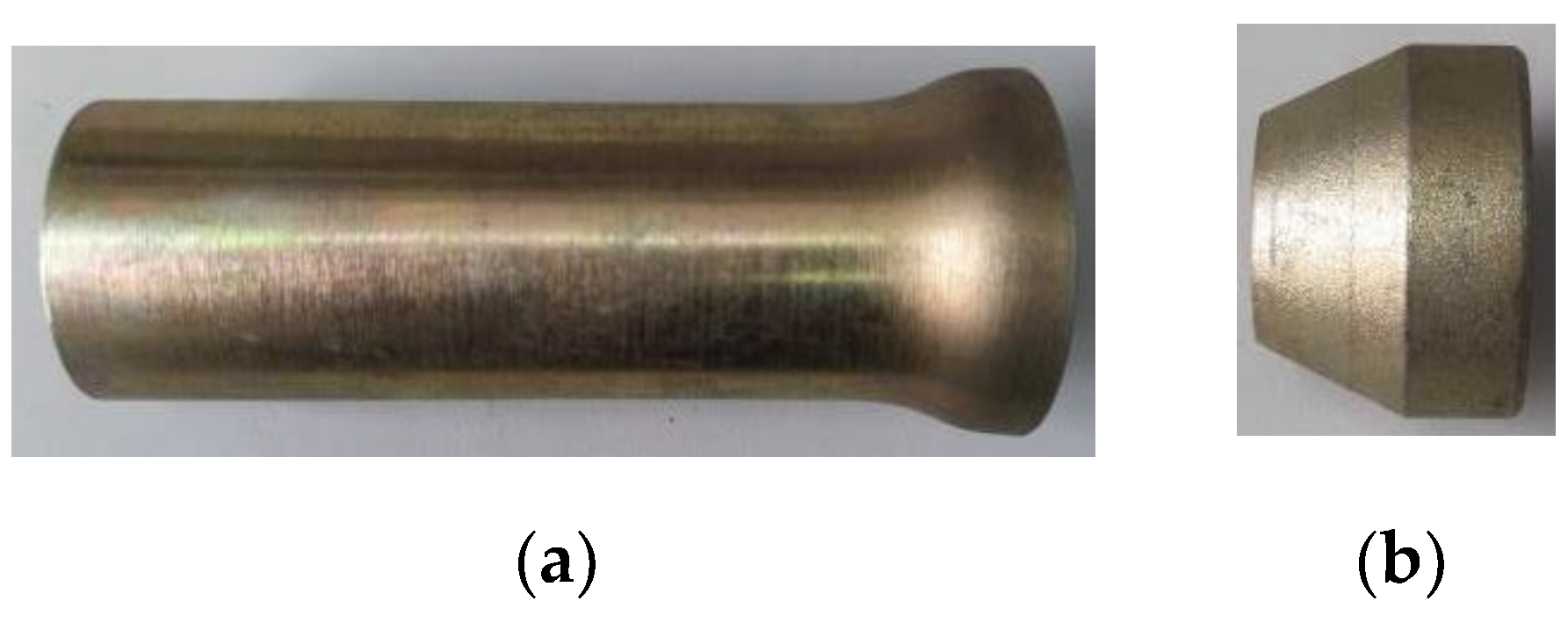
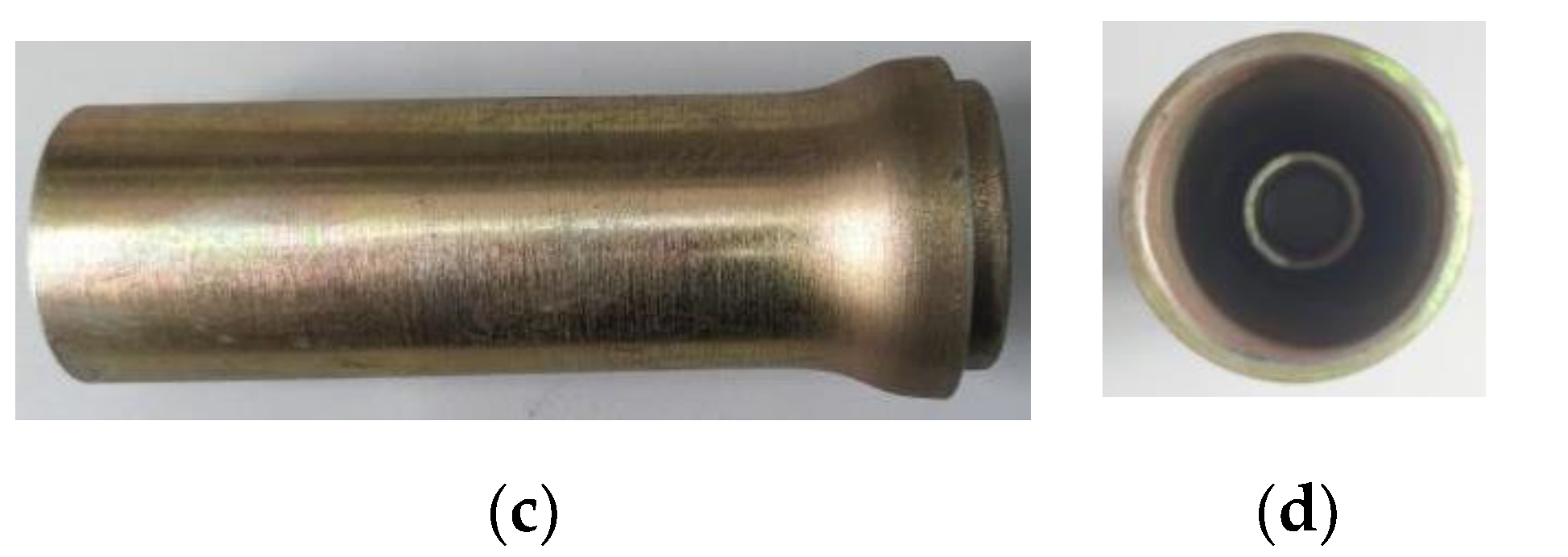

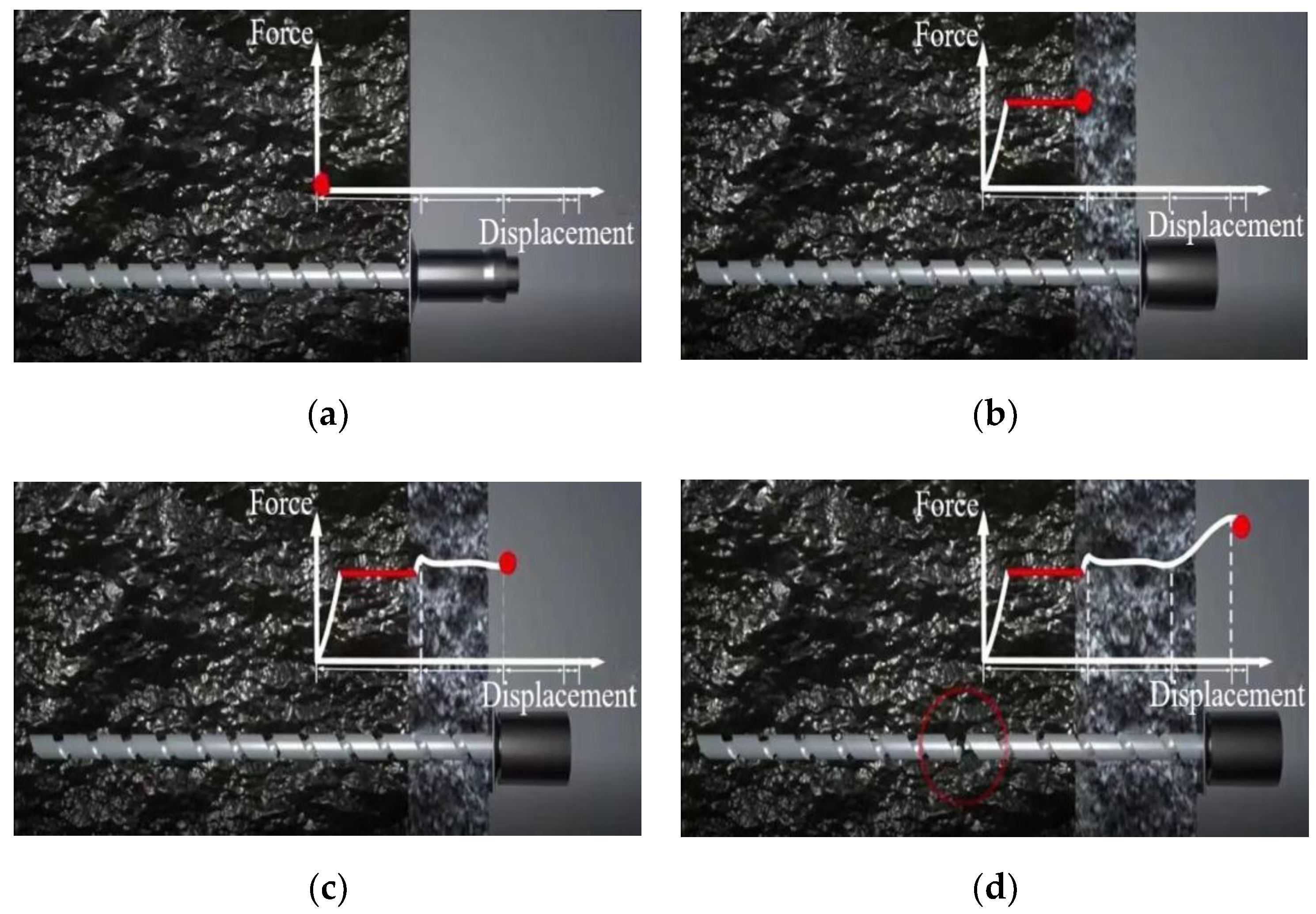
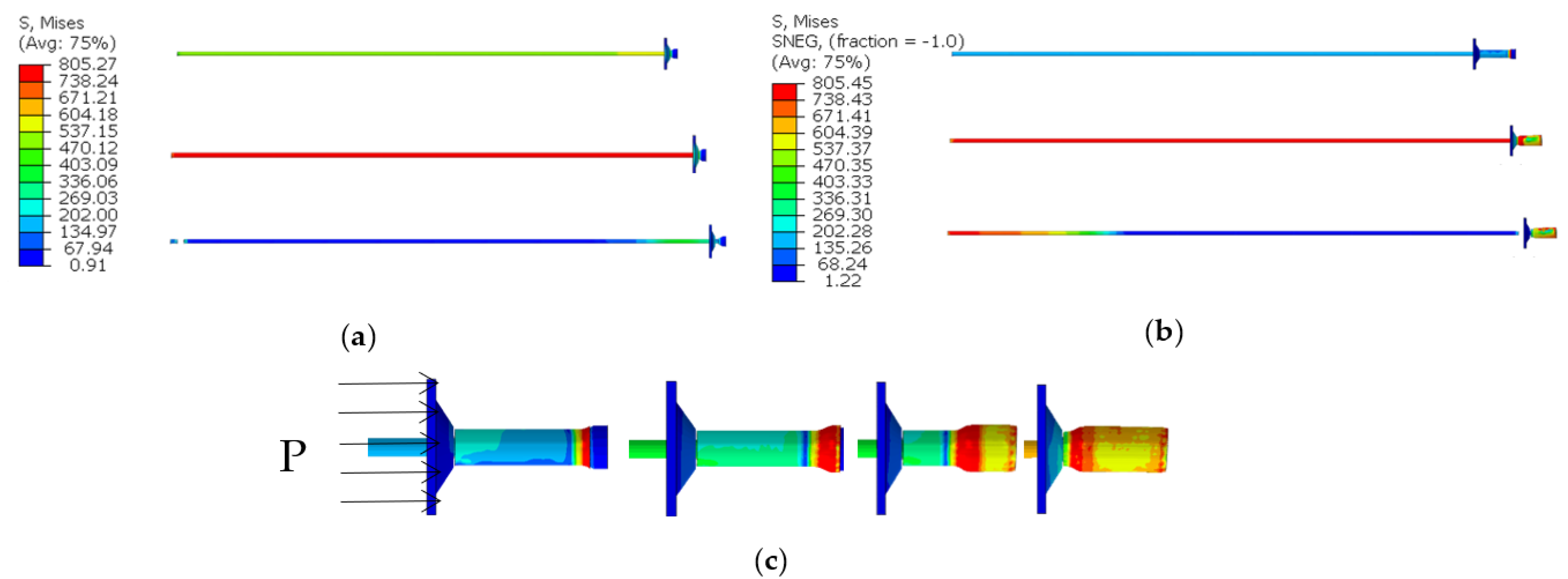
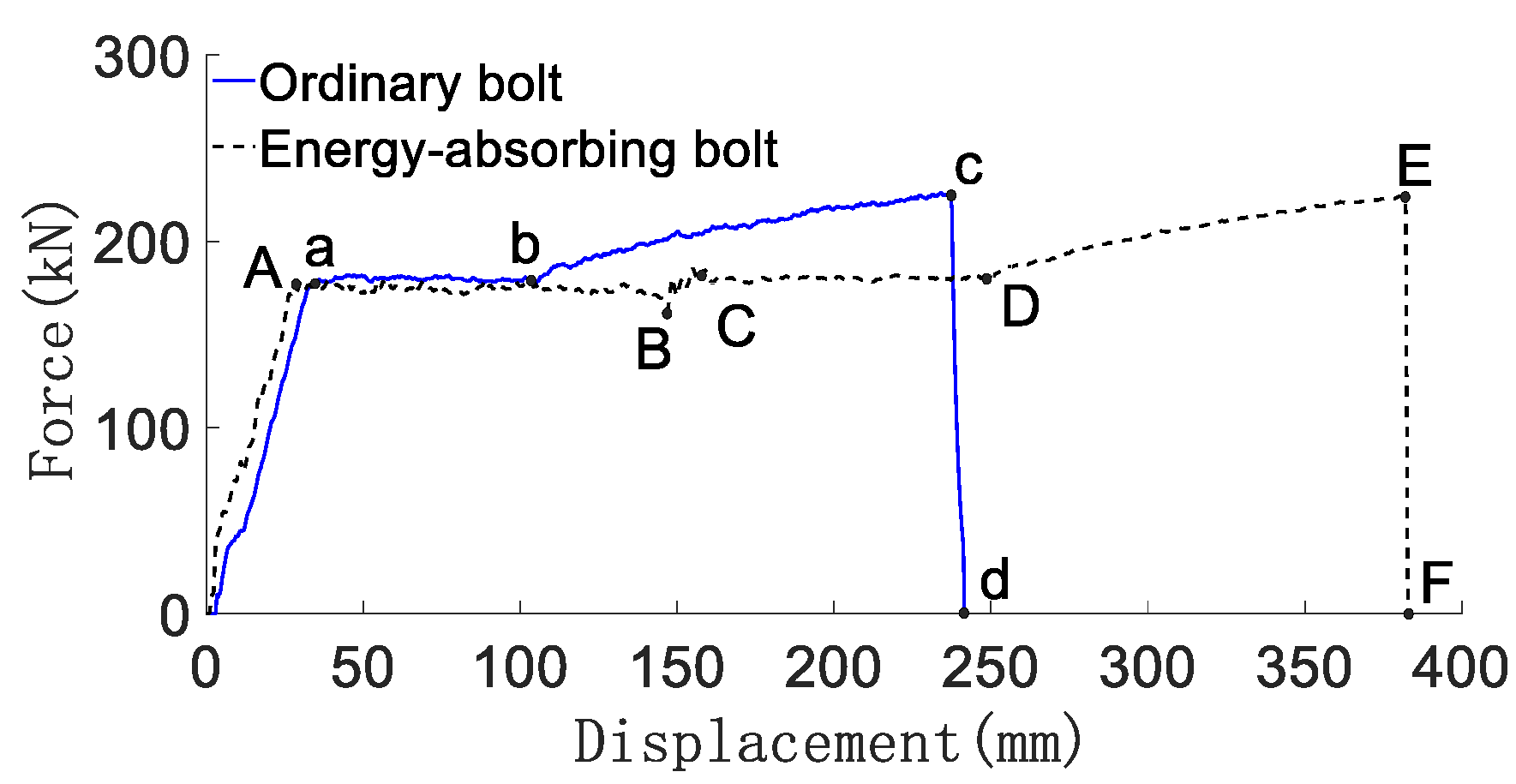



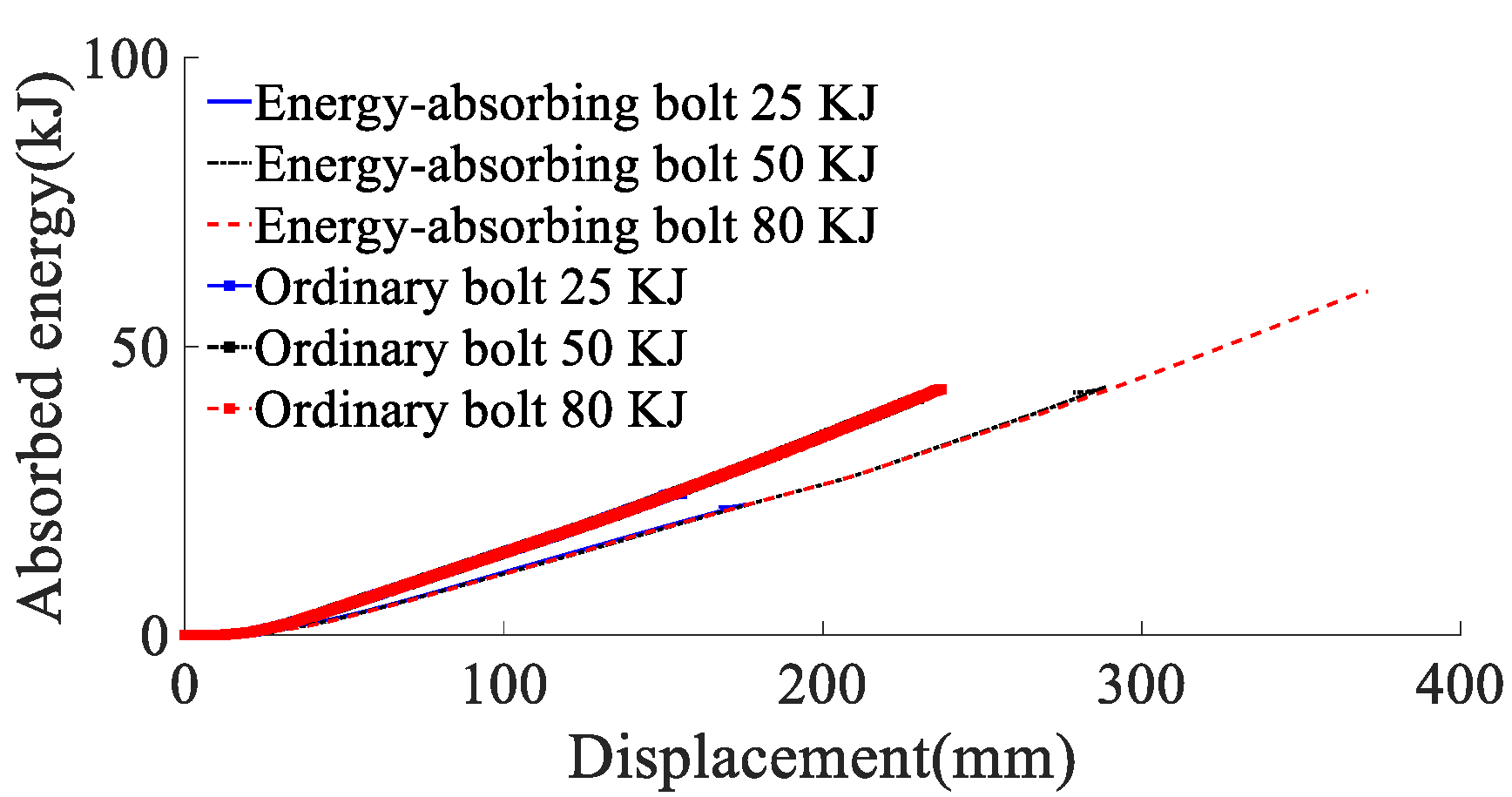


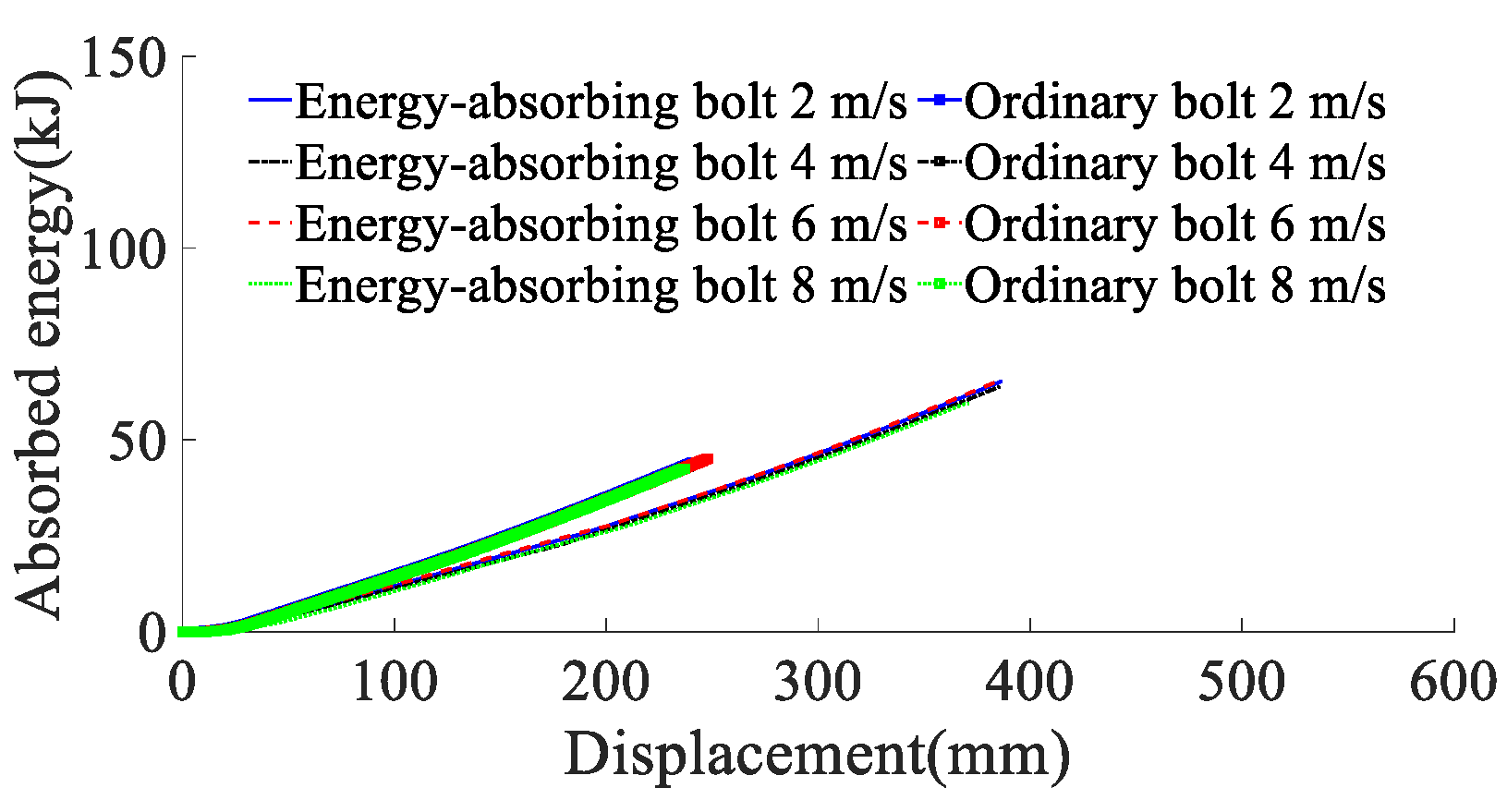

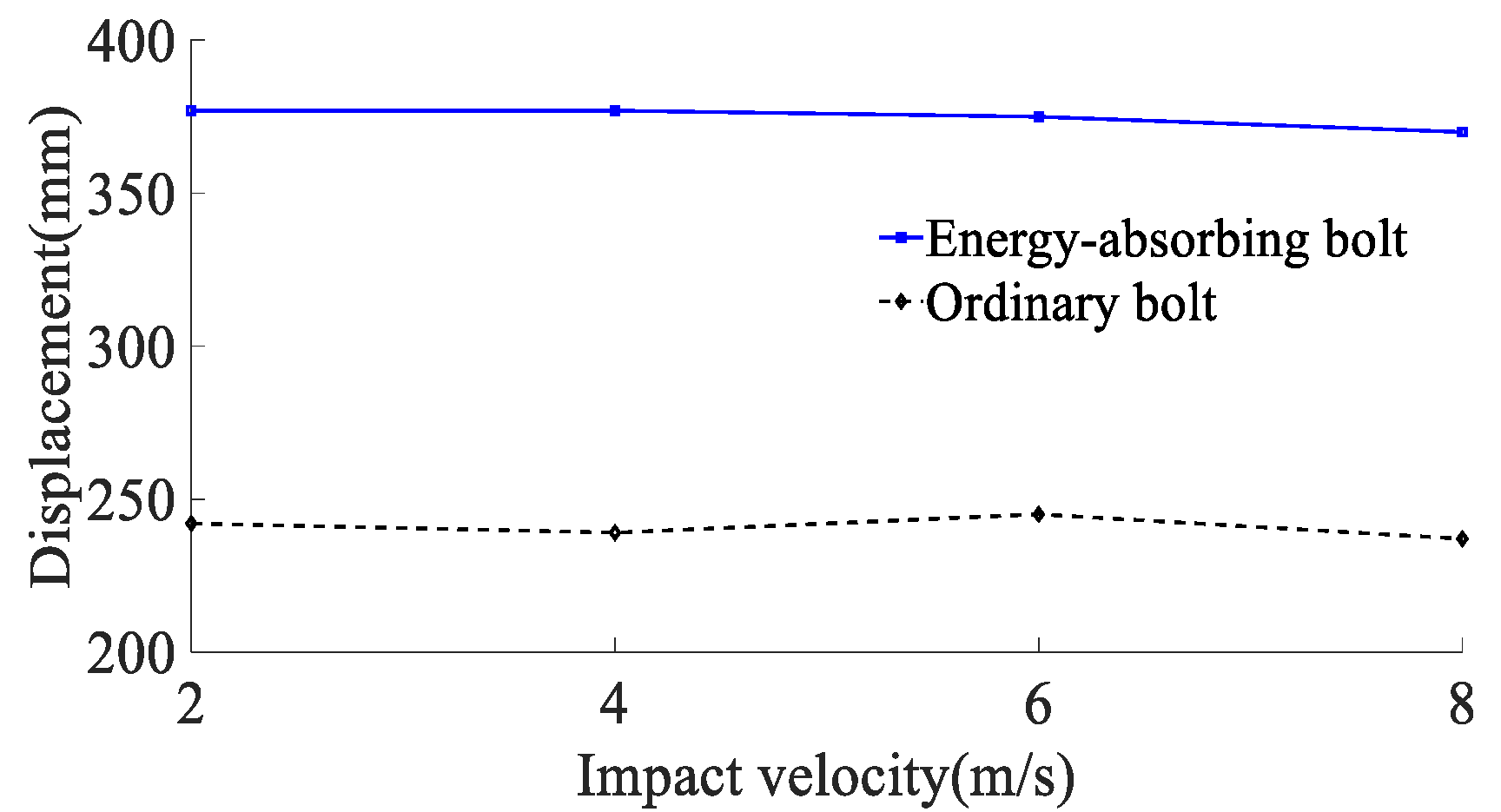



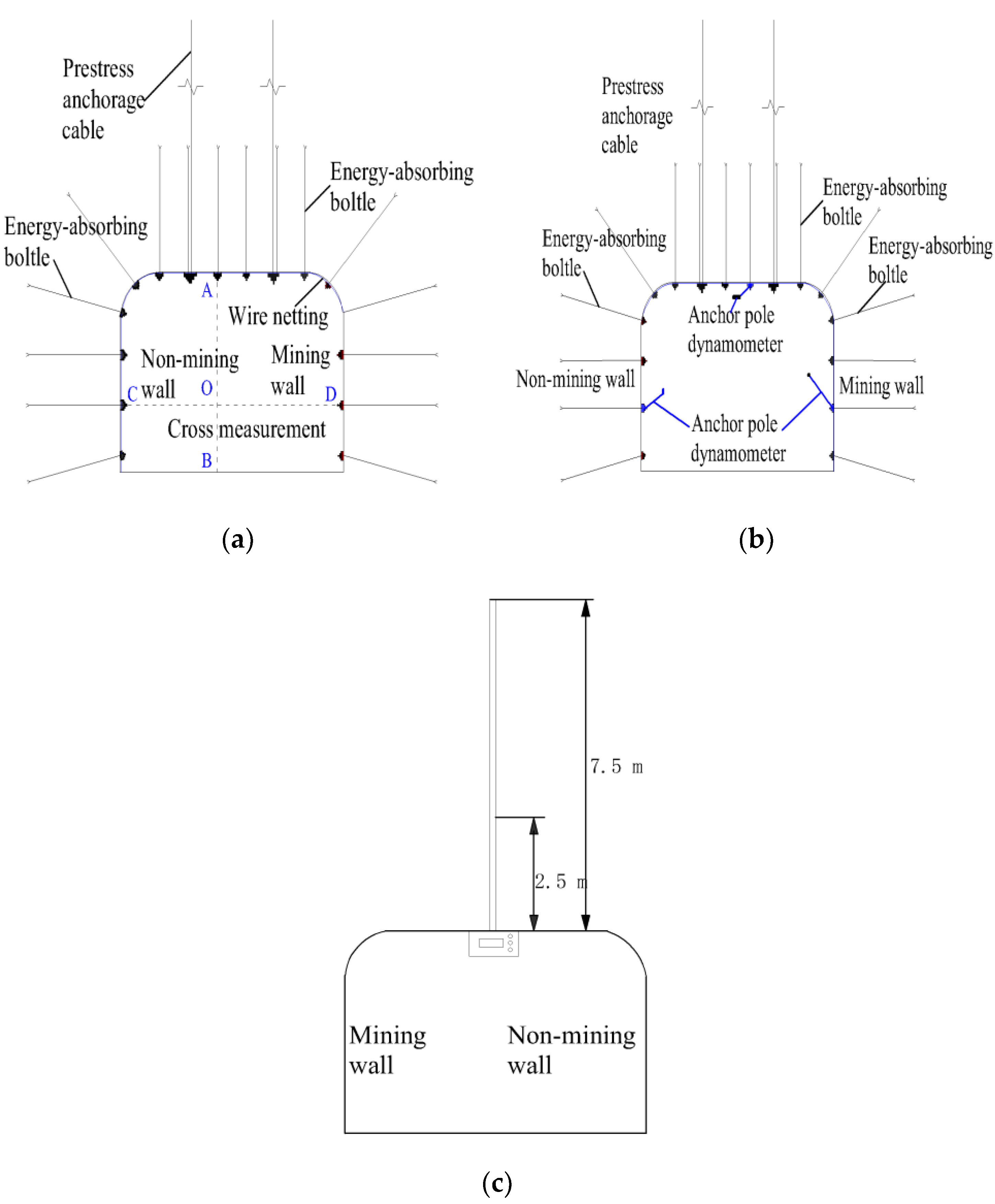
| Anchor Rods Type | Yield Load/kN | Breaking Load/kN | Energy Absorption/kJ | Letting Distance/mm | Anti-Scouring Device Bearing Capacity/kN |
|---|---|---|---|---|---|
| Conventional anchors | 178 | 226 | 43 | 240 | |
| Constant resistance energy-absorbing anti-scour anchors | 178 | 226 | 66 | 375 | 160–165 |
| Anchor Rods Type | Impact Energy/kJ | Yield Load/kN | Breaking Load/kN | Anti-Impact Time/ms | Energy Absorption/kJ | Letting Distance/mm | Anti-Scouring Device Bearing Capacity/kN |
|---|---|---|---|---|---|---|---|
| Conventional anchors | 25 | 182 | - | 44 | 24 | 155 | - |
| Conventional anchors | 50 | 183 | 227 | 39 | 41 | 233 | - |
| Conventional anchors | 80 | 183 | 224 | 35 | 43 | 237 | - |
| Constant resistance energy-absorbing anti-scour anchor rods | 25 | - | - | 53 | 23 | 176 | Approx. 152 |
| Constant resistance energy-absorbing anti-scour anchor rods | 50 | 183 | - | 77 | 43 | 289 | Approximately 156 |
| Constant resistance energy-absorbing anti-scour anchor rods | 80 | 184 | 224 | 65 | 60 | 370 | Approximately 156 |
| Anchor Type | Impact Speed/m/s | Yield Load/kN | Breaking Load/kN | Antiflush Time/ms | Rod Impact Resistance Time/ms | Energy Absorption/kJ | Anti-Puncher Give Way Distance/mm | The Distance of the Rod Gives Way/mm | Anti-Scouring Device Bearing Capacity/kN |
|---|---|---|---|---|---|---|---|---|---|
| Conventional anchors | 2 | 181 | 228 | - | 139 | 44 | - | 242 | - |
| Conventional anchors | 4 | 181 | 228 | - | 69 | 43 | - | 239 | - |
| Conventional anchors | 6 | 182 | 227 | - | 48 | 44 | - | 245 | - |
| Conventional anchors | 8 | 183 | 224 | - | 35 | 43 | - | 237 | - |
| Constant resistance energy-absorbing anti-scour anchor rods | 2 | 181 | 227 | 79 | 179 | 66 | 134 | 243 | Approximately 156 |
| Constant resistance energy-absorbing anti-scour anchor rods | 4 | 181 | 226 | 39 | 105 | 64 | 132 | 245 | Approximately 149 |
| Constant resistance energy-absorbing anti-scour anchor rods | 6 | 184 | 228 | 27 | 74 | 65 | 132 | 243 | Approximately 153 |
| Constant resistance energy-absorbing anti-scour anchor rods | 8 | 184 | 224 | 20 | 45 | 60 | 135 | 235 | Approximately 155 |
Publisher’s Note: MDPI stays neutral with regard to jurisdictional claims in published maps and institutional affiliations. |
© 2022 by the authors. Licensee MDPI, Basel, Switzerland. This article is an open access article distributed under the terms and conditions of the Creative Commons Attribution (CC BY) license (https://creativecommons.org/licenses/by/4.0/).
Share and Cite
Tang, Z.; Wu, H.; Liu, Y.; Pan, Y.; Lv, J.; Chang, D. Numerical Analysis of Mechanical Characteristics of Constant-Resistance, Energy-Absorbing and Anti-Scour Bolts. Materials 2022, 15, 3464. https://doi.org/10.3390/ma15103464
Tang Z, Wu H, Liu Y, Pan Y, Lv J, Chang D. Numerical Analysis of Mechanical Characteristics of Constant-Resistance, Energy-Absorbing and Anti-Scour Bolts. Materials. 2022; 15(10):3464. https://doi.org/10.3390/ma15103464
Chicago/Turabian StyleTang, Zhi, Hao Wu, Ying Liu, Yishan Pan, Jinguo Lv, and Dezhi Chang. 2022. "Numerical Analysis of Mechanical Characteristics of Constant-Resistance, Energy-Absorbing and Anti-Scour Bolts" Materials 15, no. 10: 3464. https://doi.org/10.3390/ma15103464
APA StyleTang, Z., Wu, H., Liu, Y., Pan, Y., Lv, J., & Chang, D. (2022). Numerical Analysis of Mechanical Characteristics of Constant-Resistance, Energy-Absorbing and Anti-Scour Bolts. Materials, 15(10), 3464. https://doi.org/10.3390/ma15103464






